JMS-T2000GC AccuTOF™ GC-Alpha 2.0
Gas Chromatograph
- Time-of-Flight Mass Spectrometer

AccuTOF™ GC-Alpha 2.0
The ultimate GC-MS system that pursues the ultimate in performance and functionality, the JMS-T2000GC AccuTOF™ GC-Alpha, has evolved into version “2.0” with the integration of a fully automated standard sample inlet and msFineAnalysis AI.
It enables automatic structural analysis of unknown compounds from comprehensive two-dimensional gas chromatography (GCxGC) data, revolutionizing the conventional approach to qualitative analysis using GC-MS.
Features
Click the "replay" button in the box above, and the movie will start (for 4 minutes).
Aiming for high performance while keeping it simple, the AccuTOF™ GC-Alpha uses three new Key Technologies.
High-performance Time-of-Flight Mass Spectrometer
Key Technology 1
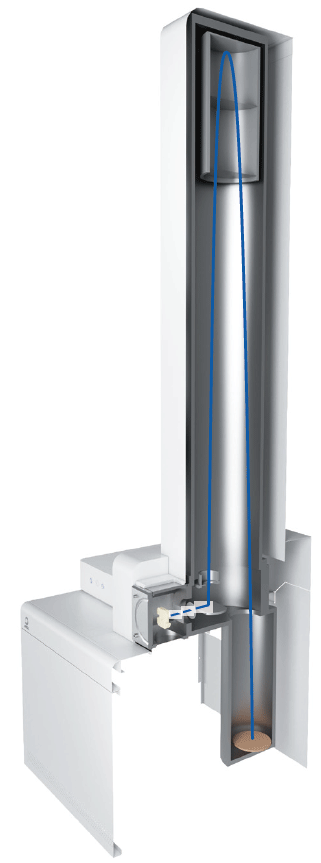
The AccuTOF™ GC-Alpha 2.0 is the 7th generation JEOL GC-TOFMS since the original AccuTOF™ GC.
The AccuTOF™ GC-Alpha 2.0 employs orthogonal-acceleration time-of-flight mass spectrometer (oaTOFMS) with dual stage reflectron, an ideal ion optical system realizing both high ion transmission (= sensitivity) and ultra-high mass resolving power.
Basic Performance of AccuTOF™ GC-Alpha 2.0
High performance for both qualitative and quantitative analysis
Four “High” specifications and two “Wide” specifications achieved simultaneously
The JMS-T2000GC AccuTOF™ GC-Alpha 2.0 is a high-performance GC-MS system that simultaneously realizes high mass resolution, high mass accuracy, high sensitivity, high speed data acquisition, wide dynamic range, and wide mass range.
The high mass resolution and high mass accuracy offers unprecedented qualitative analysis results. The high-speed data acquisition can be used for advanced GC-MS measurements such as comprehensive two-dimensional GC (GCxGC), while the wide dynamic range is useful for not only quantitative analysis but also for qualitative analysis of complex mixtures. The wide mass range is especially useful for direct MS measurements, and high sensitivity enables unprecedented information about trace components.
The AccuTOF™ GC-Alpha 2.0 is truly a high-performance GC-MS system that removes the limitations for analysis.
High Sensitivity
The standard EI ion source with ultra-high sensitivity is capable of trace quantitative analysis.
Other ion sources are also sensitive enough for qualitative analysis and can be used in a wide range of applications.
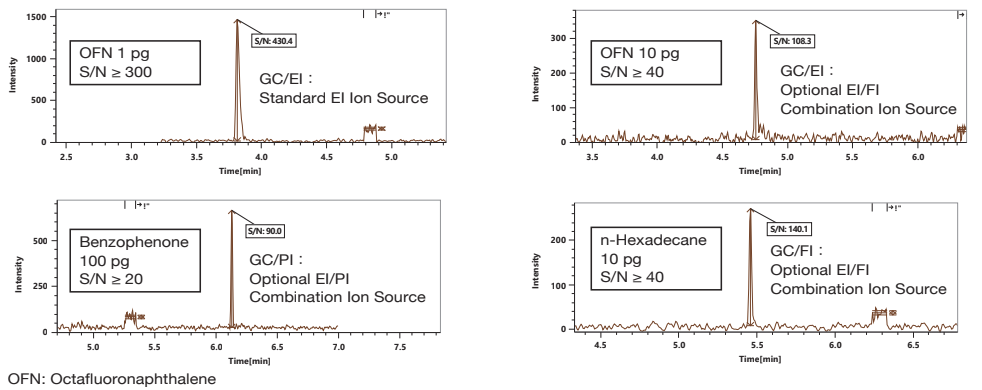
Instrument Detection Limit: IDL=18.7 fg
Eight sequential measurements of 100 fg of octafluoronaphthalene (OFN) were obtained by using the standard EI ion source.
The instrument detection limit (IDL) is calculated based on the peak area and reproducibility of the extracted ion chromatogram for the molecular ion. An IDL of 18.7 fg was achieved for the system.
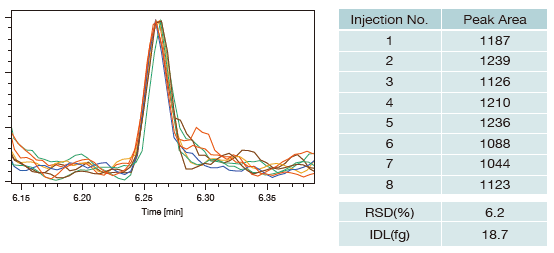
Wide Dynamic Range: 4 orders or more
OFN at concentrations ranging from 0.1 to 1,500 pg/uL (4.5 orders) were measured using the standard EI ion source and a high degree of linearity was confirmed. The wide dynamic range is useful not only for quantitative analysis but also for qualitative analysis of complex mixtures with different concentrations.
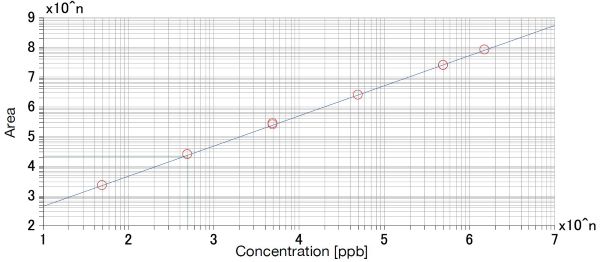
High Speed Data Acquisition: 50 Hz
For GCxGC and Fast GC analyses, the chromatographic peaks are very narrow, thus requiring a mass spectrometer that supports high-speed data acquisition. The AccuTOF™ GC-Alpha 2.0 is a good match for these advanced chromatographic techniques because it can acquire data at up to 50 spectra per second.
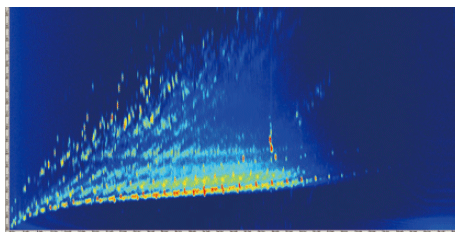
GCxGC/EI TICC of diesel fuel
Wide Mass Range: ~m/z 6,000
One of the features of time-of-flight mass spectrometers is their ability to measure a wide mass range. The upper limit of an ordinary GC-MS instrument is typically around m/z 1000, while the AccuTOF™ GC-Alpha 2.0 can detect m/z 6000 and higher. This makes it possible to use direct probe MS methods such as field desorption (FD) to measure samples like oligomers.
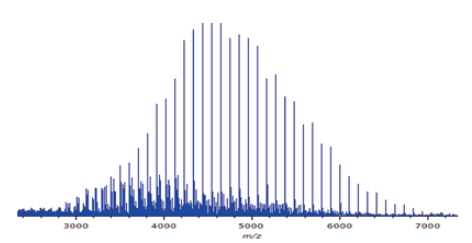
FD mass spectrum of polystyrene 5200
High Mass Resolving Power: 30,000
High mass resolving power is invaluable for qualitative analysis. Increasing the mass resolving power results in narrower mass spectral peaks, thus leading to the features below.
Increased stability of the peak centroid = improved mass accuracy
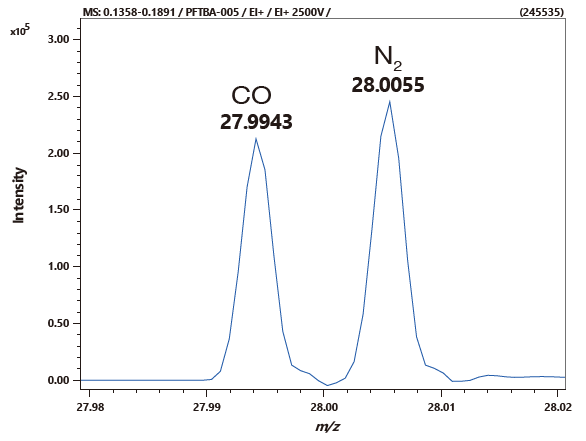
Mass separation of m/z 28
High Mass Accuracy: 1 ppm*1
High mass accuracy makes it possible to determine the elemental compositions for the observed ions. Using the "drift compensation - multiple" mass calibration function, the average mass accuracy (absolute value) for 10 ions observed from methyl stearate was 0.05 mDa or 0.45 ppm.
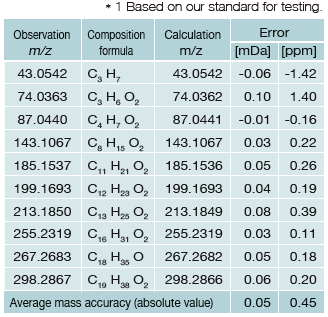

New Qualitative Analysis Capabilities offered by a Variety of Soft Ionizations
Key Technology 2
Soft ionization - a powerful tool for qualitative analysis
EI, the most widely used ionization technique in GC-MS, is superior in sensitivity and reproducibility and is supported by a variety of library searchable databases.
For any scientist using GC-MS in search of further information, what is ultimately important is molecular ion detection. EI, which uses a high ionization energy of 70 eV, generates numerous fragment ions, from which structural information is acquired. However, EI often fails to show strong molecular ion signals. Consequently, qualitative analysis results may be incorrect if they solely rely on database searches.
Thus, it is critical in GC-MS analysis to enhance the accuracy of qualitative analysis by using various soft ionization techniques in addition to EI. Chemical ionization (CI), photoionization (PI), and field ionization (FI) are all optionally available on the AccuTOF™ GC-Alpha 2.0. With the accurate mass measurement capability for all ionization techniques, elemental composition of the analyte can be reliably determined.
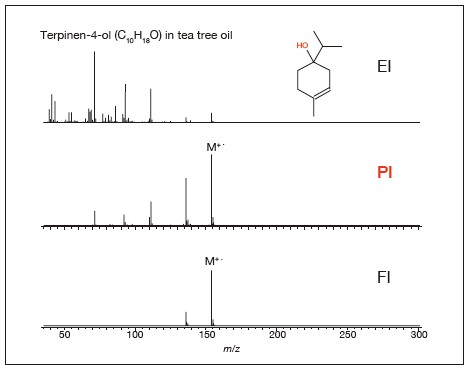
FI and FD ~ Ideal Soft Ionization Techniques for Molecular Weight Determination
FI and FD are extremely soft ionization techniques that provide lower internal energy to the analytes than EI and even CI, thus producing clear molecular ions.
As a result, FI and FD are ideal for molecular weight determination.
FI (Field Ionization)
The sample is introduced to the ion source through GC or a standard sample inlet system.
Unlike CI, FI uses no reagent gas; no need to choose a reagent gas appropriate for the analyte.
FD (Field Desorption)
The sample is applied onto the emitter and directly introduced into the system.
Suitable for analysis of thermally labile compounds.
Ideal for samples soluble in nonpolar solvents.
Analyzes powder samples dispersible in solvents.
Analyzes low- to mid-polar metal complexes.
Analyzes high molecular weight samples not supported in GC-MS, such as polymers.
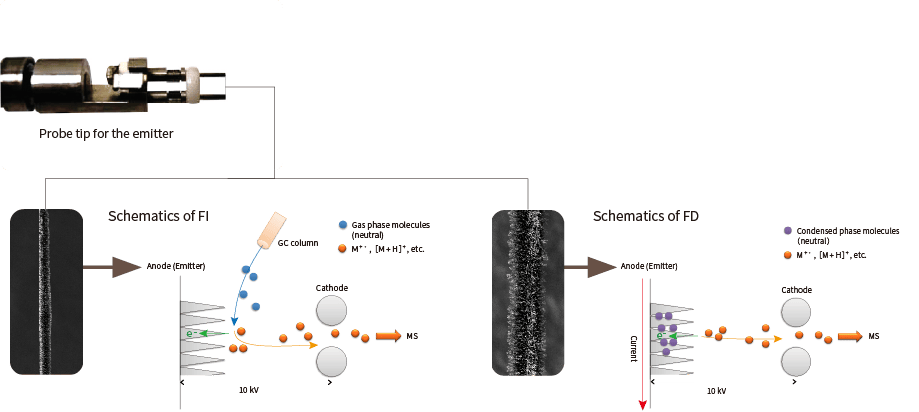
FI and FD ~ EI/FI/FD Combination Ion Source (optional)
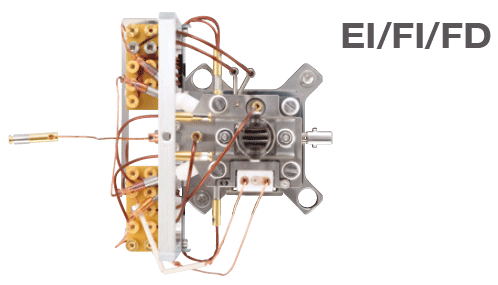
A single ion source that supports both EI (hard ionization) and FI/FD (soft ionization) techniques.
Switching between EI and FI/FD is simple and quick.
Features
• No need to replace the ion source
• No need to break the vacuum
• No need for reagent gases
The following analyses are possible by using this combination ion source with GC:
• GC/EI for qualitative analysis through library search
• GC/FI for molecular weight determination
• Accurate mass measurement
PI (Photoionization) ~ EI/PI Combination Ion Source (optional)
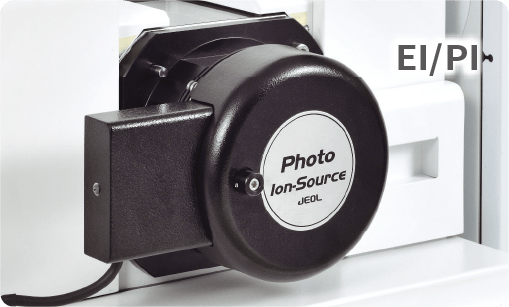
PI is an ionization method that uses photons from a vacuum ultraviolet (VUV) lamp for ionization. The AccuTOF™ GC-Alpha has an optionally available combination ion source that offers both EI (hard ionization) and PI (soft ionization). This source makes it possible to switch between EI and PI by simply turning on/off the EI filament as well as the PI lamp.
Features
No need to replace the ion source
No need to break the vacuum
No need for reagent gases
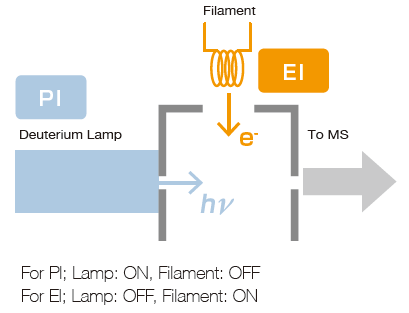
Schematics of EI/PI Combination Ion Source
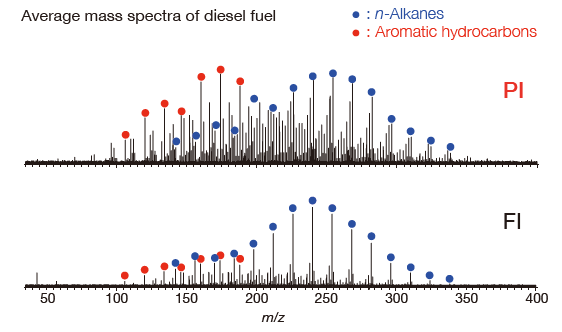
PI is particularly useful for the analysis of aromatic compounds in complex mixtures. These compounds produce high intensity peaks with PI because they strongly absorb UV light.
A New Era of Structural Analysis of Unknown Compounds
the Fusion of Cutting-edge AI Technology and Comprehensive GCxGC
Key Technology 3
msFineAnalysis AI offers a new structure analysis tool for unknown compounds that specifically designed for the JEOL JMS-T2000GC "AccuTOFTM GC-Alpha 2.0". The "Integrated Analysis" combines GC/EI, GC/Soft Ionization high resolution data, and the "AI Structure Analysis" using four AI technologies.
Version 3 supports comprehensive two-dimensional gas chromatography (GCxGC) data analysis in addition to regular GC-MS data analysis. In complex mixtures such as petroleum samples and life science samples, the ultra-high separation of GCxGC and the structural analysis of unknown compounds using msFineAnalysis AI will prove to be very effective.
These advanced AI technologies allow msFineAnalysis AI to provide a unique automatic structure analysis capability that was not previously available for GC-MS and GCxGC-MS qualitative analysis.
Innovative solutions with four AI technologies - Support molecular formula determination and structural formula estimation for unknown compounds
The msFineAnalysis AI utilizes four different AI models to automatically perform analyses on molecular formulas, substructures, and technical know-how, and provides analytical results quickly.
Features of msFineAnalysis AI

msFineAnalysis provides quick and efficient data analysis so that the user can spend less time analyzing data and more time on research and creativity!
AccuTOF™ GC-Alpha 2.0 with Direct MS
Direct MS mode is useful for the analysis of high-boiling-point and high-mass compounds that are not amenable for GC.
TOFMS with inherent wide mass range is well-matched with direct MS mode.
Compounds that are measured by GC normally have molecular weights below 500 Da so it is not common to target compounds with molecular weights exceeding 1000 Da by using GC-MS. However, in direct MS mode (no GC is used), high-boiling-point, high-molecular-weight, and nonvolatile compounds can be targeted for measurement, as the sample is directly introduced into the ion source. The mass range of the AccuTOF™ GC-Alpha is m/z 6,000 or higher. Since compounds can be detected over a wider mass range than conventional GC-MS, the system is well suited for measurements in direct MS mode.
Three Direct MS Probes To Choose From

DEP (Direct Exposure Probe)
Sample dissolved or dispersed in solvent is applied to the filament at the tip.
Suitable for high boiling point and/or thermally labile compounds
Compatible with EI and CI
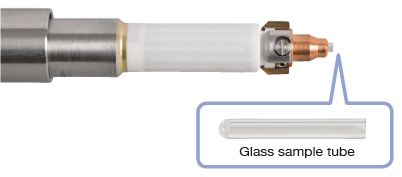
DIP (Direct Insertion Probe)
Solid sample can be introduced in the glass sample tube.
Suitable for high boiling point and/or insoluble compounds
Compatible with EI and CI
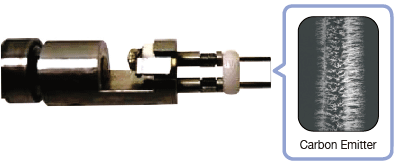
FDP (Field Desorption Probe)
Sample dissolved or dispersed in solvent is applied to the carbon emitter at the tip.
Suitable for high boiling point, high molecular weight, and/or thermally labile compounds
Suitable for low- to mid-polar metal complexes
Used for FD soft ionization
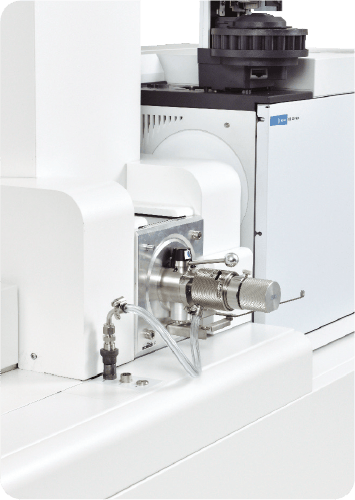
Load-lock flange for DIP/DEP/FDP
Analysis of brominated flame retardants in polypropylene products by FD (MSTips No.355)
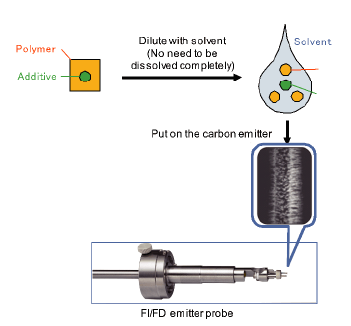
Applying the sample to the emitter
In the FD method, the sample is dissolved or dispersed with a solvent and then applied onto the emitter to be introduced into the ion source. The sample does not need to be completely dissolved in the solvent. In this case, it is possible to analyze only the additives in the solvent. Since it is a direct sample injection method without using a column, high boiling point (high mass) components can be measured. Since it is soft ionization, molecular ions can be detected. A clear difference peak was detected at m/z 943.4797 from the flame-retardant PP. It was estimated to be a brominated flame retardant by isotope pattern analysis and composition estimation.
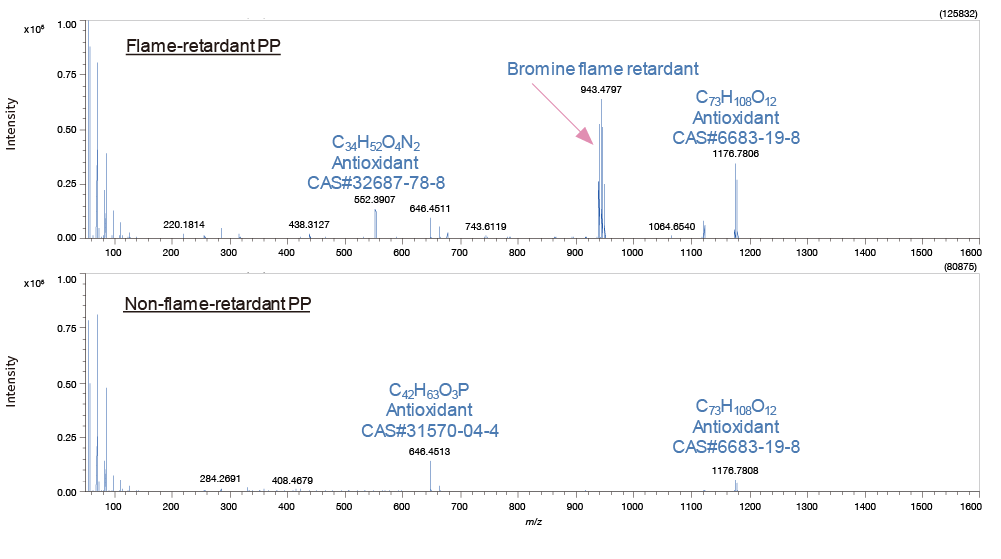
Link
News Release:
Catalogue Download
JMS-T2000GC AccuTOF™ GC-Alpha High Performance Gas Chromatograph - Time-of-Flight Mass Spectrometer
Related Products
Related Products
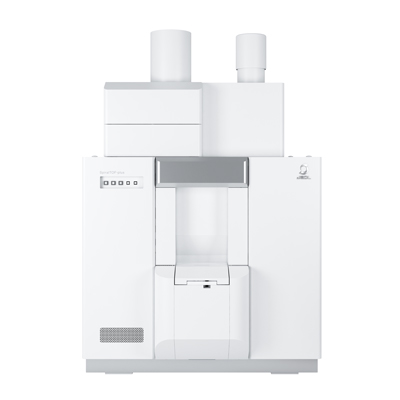
MALDI: JMS-S3000 SpiralTOF™-plus 3.0 Matrix-Assisted Laser Desorption/Ionization Time-of-Flight Mass Spectrometer
The JMS-S3000 SpiralTOF™-plus 3.0 is a MALDI-TOFMS* that uses innovative SpiralTOF ion optics that has been updated to extend the mass range of this high resolution system. The JMS-S3000 defines a new standard in MALDI-TOFMS performance and provides state-of-the-art analytical solutions for a wide range of research areas such as functional synthetic polymers, materials science, and biomolecules.
※ Clicking the Play button starts the video (approx. 4 minutes).
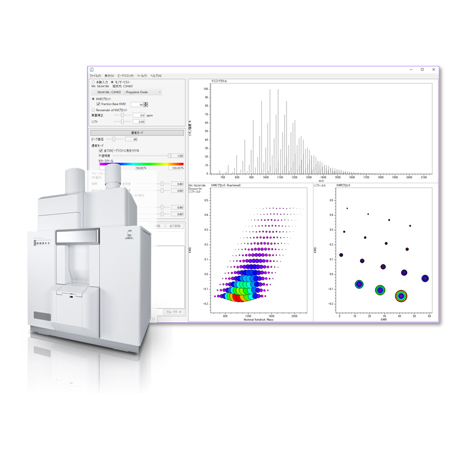
msRepeatFinder Polymer Analysis Software
Definitive Polymer Analysis Software !!
Visualizes complicated mass spectral data and accelerates information sharing !
More Info
Are you a medical professional or personnel engaged in medical care?
No
Please be reminded that these pages are not intended to provide the general public with information about the products.
